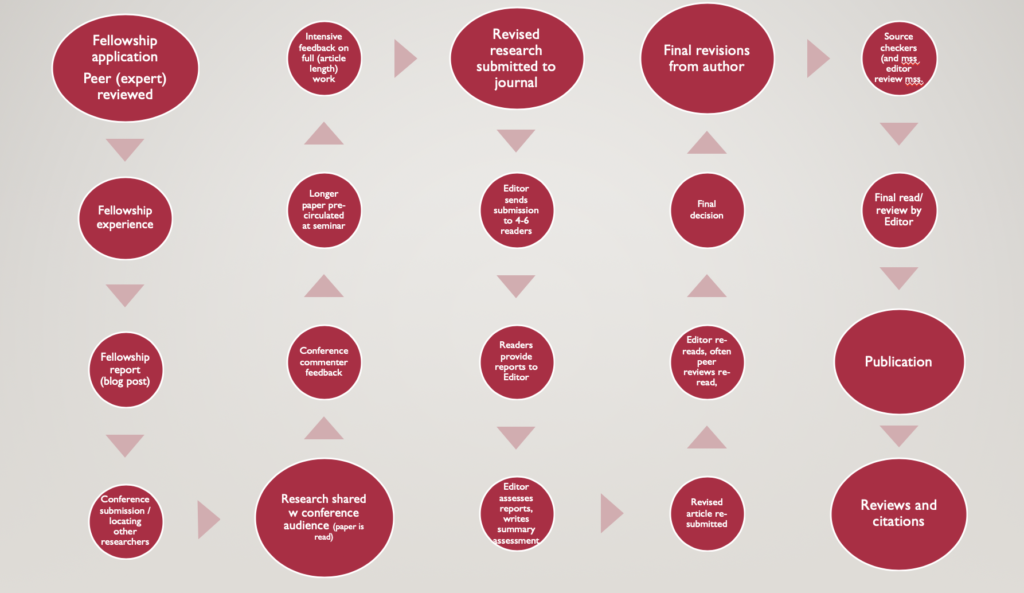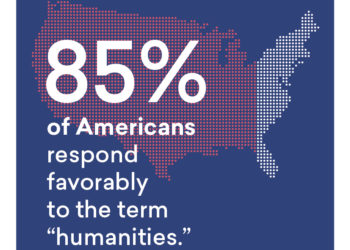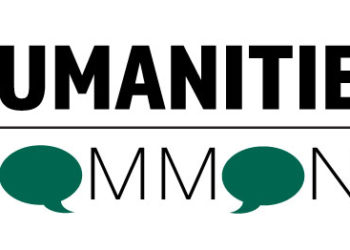Now that “Infrastructure Week” is less of an immediate US political joke, as humanities subjects and methods come under increasing political attack here and elsewhere, and perhaps especially as universities alongside other organizations are considering how to invest in an ever-more digital future, it seemed like a good time to revisit this post. Other news, too, makes this timely: the launch from annotation tool Hypothes.is of Anno, a public benefit corporation with major investment from Ithaka, for example.
In the wake of the ongoing pandemic, climate crisis, and political uncertainty, the value of the humanities perspective to our most pressing questions remains obvious to me. Yet how can we advance humanities inquiry and insight in a world which may often think of solutions as STEM-based? We know that the humanities — history, language, literature, art, and more — bring critical value to how we see, understand, and engage with the world and the people around us. We need the knowledge that humanities research and communication bring. Related, I’m just starting to read and digest what looks to be an excellent and important issue of Daedelus, the journal of the American Academy of Arts and Sciences, on “The Humanities in American Life: Transforming the Relationship with the Public.”
So how do we support what we know to be so important to social health? A crucial aspect is relatively lost-cost and high reward infrastructure. When I wrote this in 2020, Charles Watkinson, current president of the Association of University presses, commented that in addition to the institutions (libraries, namely) and services and tools that I mentioned, we could see university presses as a key form of humanities infrastructure — I’d have to agree.
What are other features of humanities infrastructure? What are the best ways to advance its value? I’d love to hear from you in the comments.
Humanities Research Infrastructure is Great ROI
Infrastructure is what enables, whether for education, sanitation or transportation for example, the development and movement of ideas and goods and services. It’s so obviously necessary that it is, perversely, regularly under-resourced. “Infrastructure week” has become a political joke in that it is always just around the corner of everyone’s best intentions but rarely garners the necessary attention or funding. The American Society for Civil Engineering’s Infrastructure Report Card, reports from the National Academy of Engineering, and more illustrate just how short-sighted it is to under-invest in physical infrastructure such as bridges and dams. The infrastructure for producing and sharing knowledge — research infrastructure — is similarly vital.

In the wake of COVID-19, which is decimating budgets everywhere, I worry that the humanities – including humanities infrastructure — may suffer when we need them most. For as much as we need science to help us comprehend and respond to this coronavirus, for just one recent resonant example, we need the humanities and social sciences to show us how and why its impact is differential and what the long history of pandemic inequalities should be teaching us. We need investment in the infrastructures that support advanced humanities research and help make that accessible research for the public good. But while there are organizations and groups of scholars attentive to humanities research infrastructure, in the wider scholarly communications industry there seems to be too little understanding of what it is, what it does, and thus why we should be investing in it.
Over the last year I’ve spoken at several conferences about the features of humanities research infrastructure, including the April 2020 Society for Scholarly Publishing (SSP) webinar on “Building a Sustainable Research Infrastructure.” Alice Meadows, who convened the group, followed up with a post summarizing the webinar and the shared sense that “a strong and sustainable research infrastructure — the tools, services, and systems that support the research process — is vital.” We all focused on persistent identifiers (PIDs), though for my colleagues in the webinar this was primarily about increasing the discoverability and usability of scientific research, and reducing friction, overlap, and incompatibility in systems and tools. (I’m summarizing a rich discussion here, and Alice’s post also shared the very interesting feedback from attendees whose responses to different questions about infrastructure were captured in word clouds.)
My contributions have focused on the ways that humanistic inquiry doesn’t fit many of the guiding assumptions about infrastructure, and the tools that are being built to match them. Retrofitting tools designed for high volume scientific research and publication so that humanists can use them, for example, is inefficient at best, but it also undermines the potential to fully appreciate the diversity of research practices and – even more importantly — the variety of critical contributions from diverse research pursuits. Likewise insisting on scalability as a key value for infrastructure by its nature flattens out the very diversity that drives innovative scholarship.
Humanities research infrastructure does not look like STEM infrastructure either in kind or scale, even allowing that generalizing for the humanities can be as misleading as generalizing for STEM. But in the humanities, we still don’t regularly think of having a research infrastructure. Even with the advent of digital resources, the individual author, relatively low cost, relatively low tech nature of research and the practices of refining and disseminating research can make our infrastructure all but invisible — even to ourselves. The still-siloed nature of critical and expert professional positions and practices within that infrastructure, including researchers, archivists and librarians, and editors and publishers, exacerbate crises of support for that near-invisible yet critical infrastructure.
So what does humanities research infrastructure look like? If we step back from the idea of a unitary research infrastructure largely driven by the particular needs and interests of high volume (and high dollar) STEM fields, and looked at the needs and priorities of different research ecosystems, what would we find? Perhaps humanities infrastructure looks more appropriately like a series of streams in a watershed rather than, a priori, a digital superhighway? Since we often refer to the “ecosystem” of scholarly communications I can’t resist observing that a watershed is a more sustainable and healthy ecosystem than a super highway.
As always, some historical context is important. These questions about humanities research infrastructure – and how it might or might not bear any relationship to STEM research infrastructure — are not new. Though this is not a literature review, I have referenced some representative reports and scholarship from the US and Europe, with an emphasis on my own discipline of history. In 2004 the American Council of Learned Societies (ACLS) charged a “Commission on Cyberinfrastructure”; the resulting 2006 report, Our Cultural Commonwealth, is worth reading for what remains a priority for humanities research and scholarship, but also for the consistent focus of humanities infrastructure: primarily on putting “the world’s cultural heritage…within the reach of every citizen” to give “all citizens access to the human record and the opportunity to participate in its creation and use.” That typically means digitizing collections within libraries and archives, enhancing and connecting cataloguing, and then creating robust platforms for accessing those materials. This could be individual holding collections creating digital surrogates and access, or thematic projects pulling materials from multiple collections. Examples in the ACLS report included now-legacy projects such as the Salem Witch Trials Documentary Archive and Transcription Project at the University of Virginia. A great example of a current project in this vein is Colored Conventions, which brings together records and analysis (including exhibits and teaching modules) illuminating the history of African American political organizing in the nineteenth-century U.S. Colored Conventions is also a terrific example of the critical role of particular funders for humanities research infrastructure; a $75,000 Digital Humanities Start-up grant from the National Endowment for the Humanities in 2017 and a $200,000 grant from the Andrew W. Mellon Foundation the following year to expand collaborations illustrate just a couple of the forms that important role takes.
The European Science Foundation has been active in scoping and supporting humanities research infrastructure — but expressly for digital humanities. The ESF 2011 report “Research Infrastructure in the Digital Humanities” is worth reflection in part for its effort to define humanities infrastructure. For some humanists, the report observed, “an infrastructure is the technical and operational framework that allows them to collaborate and share data and results; for some it is the content to which access is offered rather than the facilities around it; and for some it is both.” The report goes on to embrace the particular “cyberinfrastructure” and notes the how “colleagues in the Sciences and Technology have made a profound contribution to the development” of Research Infrastructures even while those “cannot simply be transferred to Humanities ‘out of the box.’”
For some humanists…”an infrastructure is the technical and operational framework that allows them to collaborate and share data and results; for some it is the content to which access is offered rather than the facilities around it; and for some it is both.” ESF, Research Infrastructure in the Digital Humanities (2011)
This remains the crux. How to create research infrastructure that doesn’t, as a 2013 essay by Reto Speck and Petra Linksput it, simply “transfer the [STEM] values of faster, bigger and better” and is instead “fit for its intended purpose.” They argue that one of the key things infrastructure can do is support collaboration — in the case they advocate for, that of archivists and scholars — in knowledge production. The specific issue they’re engaged with is the potentially diminished or elided role of archivists’ expertise in a digital archival environment and the consequent reduced access for researchers to that expertise. What if we built research infrastructure that is more attuned to facilitating and even enhancing the knowledge producing potential of collaboration (especially a legacy form of collaboration that was and is often expressly facilitated by in person physical archival research)?
In Big Digital Humanities: Imagining a Meeting Place for the Humanities and the Digital Patrick Svensson takes up some of the regular issues around digital humanities, but for my purposes chapter 4, “Humanities Infrastructure,” is key. Like the ESF, Svensson is focused on digital humanities — or what he terms “big digital humanities” — but also on what infrastructure is useful “more broadly in supporting the humanities.” He argues that humanists should be thinking carefully and explicitly about infrastructure, advocating for digital humanities labs. But Svensson worries that the “humanities as a whole lacks the capacity to imagine and implement intellectually driven infrastructure.” But we are in a moment when we should seize the “intellectual challenge” of creating — first defining — what humanities infrastructure will be.
So does the humanities have a research infrastructure — cultural heritage content held in libraries and made more accessible and discoverable via digitization, projects which pull those materials together for analyzing and communicating their value, digital humanities platforms and laboratories — or doesn’t it? It does, and what brings these types of humanities infrastructure together is that whether materials-based (content) or process-based (projects) or tools-based (platforms and laboratories), you could swap each for the other in an iterative process of knowledge creation. Digitization of materials involves critical intellectual expertise and labor, laboratories involve critical technical skills, for example.
What’s largely missing, and what’s front and center in STEM-focused discussions of research infrastructure, is publishing. My colleagues in the sessions I referenced have emphasized how important it is to create persistent and cross-referenced content. So, for example, when Alice asked in our SSP webinar if we could have “one wish for how to change our research infrastructure” Gabriela Mejas championed PIDs for organizations, grants, projects, conferences, instruments, and cultural artefacts. Interoperability and connection is the key. For humanists, this might look somewhat different, though I appreciated Gabi’s inclusion of cultural materials and conference participation, both key to humanities research.
Humanities publishing is a central aspect of the humanities research infrastructure, but is typically the end of a long process of sharing and review of research and interpretation that takes place well before formal peer review. Conferences or seminars are where initial work is presented and commented on, where ideas for revisions develop. Because analysis is the central feature of humanities research, and that analysis is expressed as carefully constructed prose, our writing is our research output. Each stage of writing and feedback and revision also exemplifies collaborative knowledge production, though most publications bear a single author’s name. Supporting humanities research infrastructure then, would mean supporting these many stages of interaction and iterative research.
I crafted this (too general) graphic of how a piece of historical research might develop, from first research into publication. It certainly does not represent how all research develops, and it over-represents a privilege of those researchers who are funded (albeit at a scale that is so very, very much smaller than for STEM) and are able to share their work in professional settings such as seminars and workshops. Still, it helps to show just how much collaborative feedback is essential to the eventual publication of humanities research.
If we connect the types of largely cyberinfrastructure depicted in the 2006 ACLS report through Svensson’s 2016 book with the human expertise, skill, and time committed to the route to publishing that I’ve depicted, we begin to get a sense of how very different humanities research infrastructure looks. How would we invest in this work, which is right now bringing us crucial insights about, for example, the long history of police violence? We would do well to attend to the health of some of the major investors in humanities, government agencies and foundations, but also to the fate of the libraries and universities that incubate humanistic inquiry. But also, quite crucially, to how critical phases of humanities research is — or largely is not — integrated into the tools that are seen as key to research infrastructure writ large.




